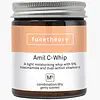What's inside
What's inside
 Key Ingredients
Key Ingredients

 Benefits
Benefits

 Concerns
Concerns

 Ingredients Side-by-side
Ingredients Side-by-side

Aloe Barbadensis Leaf Juice
Skin ConditioningWater
Skin ConditioningZinc Oxide
Cosmetic ColorantCaprylic/Capric Triglyceride
MaskingPongamia Glabra Seed Oil
Skin ConditioningGlycerin
HumectantPolyglyceryl-10 Myristate
Skin ConditioningPolyglyceryl-10 Stearate
Skin ConditioningMica
Cosmetic Colorant2,3-Butanediol
HumectantGlyceryl Isostearate
EmollientMaltodextrin
AbsorbentSilica
AbrasiveSalicylic Acid
MaskingHelianthus Annuus Seed Oil
EmollientTocopherol
AntioxidantCaesalpinia Spinosa Fruit Pod Extract
Helianthus Annuus Sprout Extract
Skin ConditioningBenzyl Alcohol
PerfumingPolyhydroxystearic Acid
EmulsifyingXanthan Gum
EmulsifyingCitric Acid
BufferingSodium Hydroxide
BufferingSorbic Acid
PreservativeAloe Barbadensis Leaf Juice, Water, Zinc Oxide, Caprylic/Capric Triglyceride, Pongamia Glabra Seed Oil, Glycerin, Polyglyceryl-10 Myristate, Polyglyceryl-10 Stearate, Mica, 2,3-Butanediol, Glyceryl Isostearate, Maltodextrin, Silica, Salicylic Acid, Helianthus Annuus Seed Oil, Tocopherol, Caesalpinia Spinosa Fruit Pod Extract, Helianthus Annuus Sprout Extract, Benzyl Alcohol, Polyhydroxystearic Acid, Xanthan Gum, Citric Acid, Sodium Hydroxide, Sorbic Acid
Water
Skin ConditioningBis-Ethylhexyloxyphenol Methoxyphenyl Triazine
Skin ConditioningNiacinamide
SmoothingCoco-Caprylate
EmollientButyloctyl Salicylate
Skin ConditioningGlyceryl Stearate
EmollientPolyglyceryl-6 Stearate
EmollientMicrocrystalline Cellulose
AbsorbentSodium Ascorbyl Phosphate
AntioxidantLactic Acid
BufferingCetyl Alcohol
EmollientTocopherol
AntioxidantGlycerin
HumectantSodium Anisate
AntimicrobialSodium Levulinate
Skin ConditioningGlyceryl Caprylate
Emollient3-O-Ethyl Ascorbic Acid
Skin ConditioningPolyglyceryl-6 Behenate
Emulsion StabilisingRosa Canina Fruit Extract
AstringentGellan Gum
Xanthan Gum
EmulsifyingSodium Phytate
Citrus Limon Fruit Oil 0.475%
AstringentWater, Bis-Ethylhexyloxyphenol Methoxyphenyl Triazine, Niacinamide, Coco-Caprylate, Butyloctyl Salicylate, Glyceryl Stearate, Polyglyceryl-6 Stearate, Microcrystalline Cellulose, Sodium Ascorbyl Phosphate, Lactic Acid, Cetyl Alcohol, Tocopherol, Glycerin, Sodium Anisate, Sodium Levulinate, Glyceryl Caprylate, 3-O-Ethyl Ascorbic Acid, Polyglyceryl-6 Behenate, Rosa Canina Fruit Extract, Gellan Gum, Xanthan Gum, Sodium Phytate, Citrus Limon Fruit Oil 0.475%
 Reviews
Reviews

Ingredients Explained
These ingredients are found in both products.
Ingredients higher up in an ingredient list are typically present in a larger amount.
Glycerin is already naturally found in your skin. It helps moisturize and protect your skin.
A study from 2016 found glycerin to be more effective as a humectant than AHAs and hyaluronic acid.
As a humectant, it helps the skin stay hydrated by pulling moisture to your skin. The low molecular weight of glycerin allows it to pull moisture into the deeper layers of your skin.
Hydrated skin improves your skin barrier; Your skin barrier helps protect against irritants and bacteria.
Glycerin has also been found to have antimicrobial and antiviral properties. Due to these properties, glycerin is often used in wound and burn treatments.
In cosmetics, glycerin is usually derived from plants such as soybean or palm. However, it can also be sourced from animals, such as tallow or animal fat.
This ingredient is organic, colorless, odorless, and non-toxic.
Glycerin is the name for this ingredient in American English. British English uses Glycerol/Glycerine.
Learn more about GlycerinTocopherol (also known as Vitamin E) is a common antioxidant used to help protect the skin from free-radicals and strengthen the skin barrier. It's also fat soluble - this means our skin is great at absorbing it.
Vitamin E also helps keep your natural skin lipids healthy. Your lipid skin barrier naturally consists of lipids, ceramides, and fatty acids. Vitamin E offers extra protection for your skin’s lipid barrier, keeping your skin healthy and nourished.
Another benefit is a bit of UV protection. Vitamin E helps reduce the damage caused by UVB rays. (It should not replace your sunscreen). Combining it with Vitamin C can decrease sunburned cells and hyperpigmentation after UV exposure.
You might have noticed Vitamin E + C often paired together. This is because it is great at stabilizing Vitamin C. Using the two together helps increase the effectiveness of both ingredients.
There are often claims that Vitamin E can reduce/prevent scarring, but these claims haven't been confirmed by scientific research.
Learn more about TocopherolWater. It's the most common cosmetic ingredient of all. You'll usually see it at the top of ingredient lists, meaning that it makes up the largest part of the product.
So why is it so popular? Water most often acts as a solvent - this means that it helps dissolve other ingredients into the formulation.
You'll also recognize water as that liquid we all need to stay alive. If you see this, drink a glass of water. Stay hydrated!
Learn more about WaterXanthan gum is used as a stabilizer and thickener within cosmetic products. It helps give products a sticky, thick feeling - preventing them from being too runny.
On the technical side of things, xanthan gum is a polysaccharide - a combination consisting of multiple sugar molecules bonded together.
Xanthan gum is a pretty common and great ingredient. It is a natural, non-toxic, non-irritating ingredient that is also commonly used in food products.
Learn more about Xanthan Gum